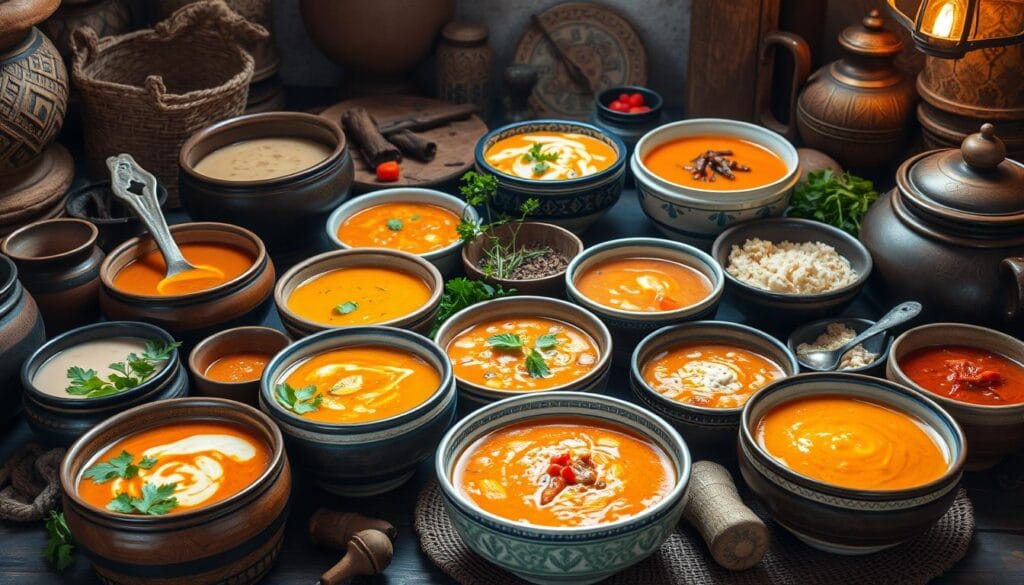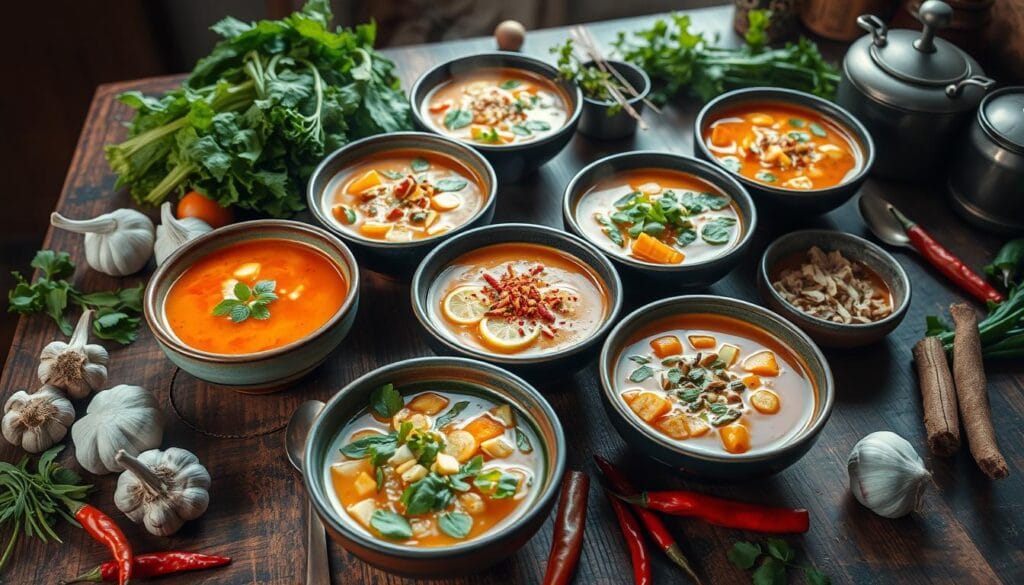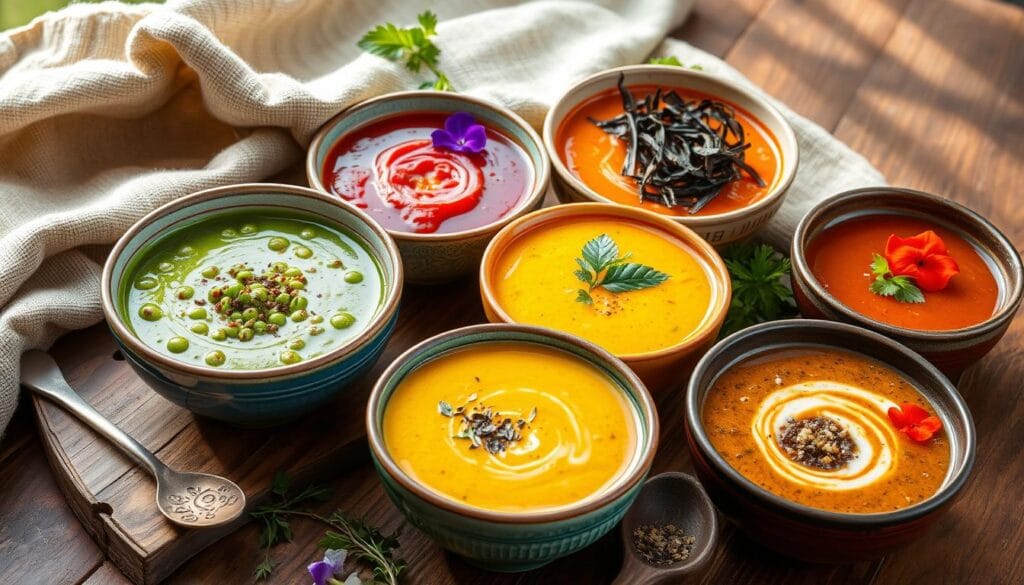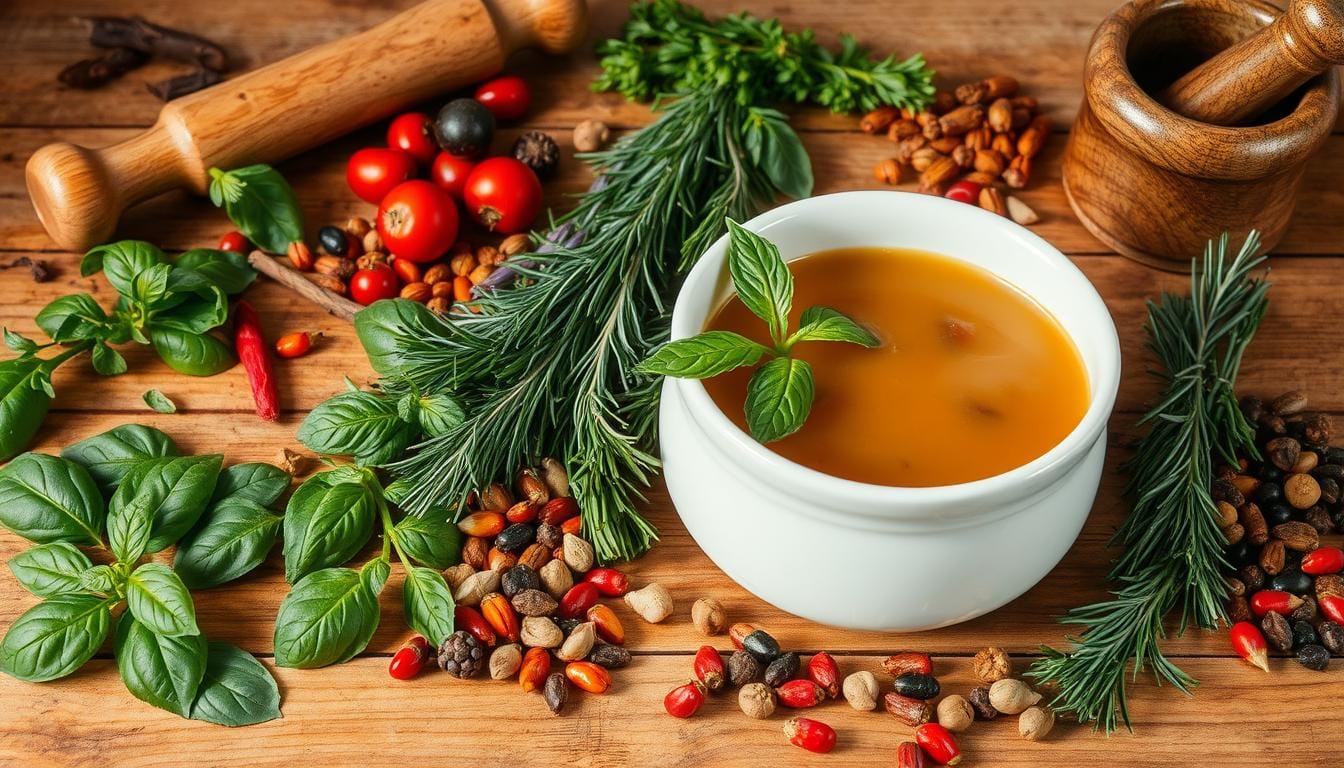Soups bring warmth and comfort to people all over the world. But what makes a great soup? In this guide, we’ll explore the key elements that make soups so loved. You’ll learn how to make rich broths and choose the best ingredients.
Whether you’re a beginner or looking to improve, this article is for you. Seasoned cooks share their tips on timing and technique. You’ll see how these can make your soup truly special.
Key Takeaways
- Understand the importance of a rich broth to enhance flavor.
- Learn essential soup making techniques for better outcomes.
- Identify the best ingredients to elevate your soup dishes.
- Explore how timing can greatly impact flavor development.
- Discover secrets from experienced cooks to create delightful soups.
The Secret to Making Soup: A Timeless Comfort Food
Soup has been a key part of soup history for centuries. It’s a nourishing staple in many cultures. Different global soup varieties show off the unique cooking traditions of each region.
In France, it’s all about the aromatic bouillon. In Japan, it’s the rich miso soup. Each culture has its own special way of making soup, using local ingredients and tastes.
For many families, home cooking means a pot of simmering soup. It’s not just for the taste, but also for the warmth it brings. Gathering around a bowl of soup creates lasting memories.
Whether it’s a hearty gumbo from the South or a simple vegetable soup, soup is a big part of our lives.

Why the Secret to Making Soup Starts with Broth?
The secret to making soup lies in its foundation: the broth. A well-made broth, whether it’s chicken, beef, or vegetable-based, is the soul of a great soup. Simmering fresh ingredients like bones, aromatics, and herbs for hours results in a rich and flavorful base. If you’re looking for a step-by-step guide, check out our detailed recipe for homemade chicken broth, which is perfect for enhancing your favorite soups.
Understanding the Role of Broth
Broth is the heart of soup, carrying most of its flavor. Using top-notch ingredients makes a broth full of taste and nutrients. It’s important to simmer ingredients correctly to get the most flavor and health benefits. Here are some tips for making broth:
- Base Ingredients: Pick fresh, organic stuff for a strong flavor.
- Cooking Time: Longer simmering means more flavor.
- Temperature Control: Simmering is better than boiling for richer broth.
Key Techniques for Mastering the Secret to Making Soup
There are more secrets to making soup great than just the broth. These techniques involve careful preparation and execution:
- Sautéing Aromatics: Start by cooking onions, garlic, or herbs in oil for a tasty base.
- Cohesive Flavor Building: Add ingredients in layers for more depth.
- Final Adjustments: Taste and adjust flavors at the end for the perfect balance.
Using these tips and understanding broth’s importance will help you make a memorable secret soup recipe. Mastering these techniques is key for anyone wanting to improve their soup-making skills.
Essential Ingredients for Delicious Soup
Making a great soup starts with the ingredients. Choosing the best ingredients makes every spoonful better. Fresh produce adds flavor and health benefits. Vegetables, herbs, and proteins are key to a delicious soup.
Best Ingredients to Unlock the Secret to Making Soup
Some ingredients are must-haves for flavor:
- Onions – Adds depth and sweetness.
- Garlic – Offers a pungent, aromatic kick.
- Carrots – Brings natural sweetness and color.
- Celery – Contributes a fresh, crunchy texture.
- Herbs – Fresh parsley and thyme are excellent for brightening the taste.
The Importance of Fresh Produce
Fresh produce is key for flavor and health. Always choose the best vegetables. At the market, look for:
| Vegetable | Signs of Freshness |
|---|---|
| Carrots | Firm texture, bright orange color |
| Onions | Dry papery skin, no soft spots |
| Garlic | Firm bulbs, tight skin |
| Herbs | Bright green leaves, no wilting |
Adding proteins like chicken, beans, and lentils makes the soup more filling. When you mix these ingredients well, you get a soup that’s both tasty and healthy.

Perfect Soup Seasoning: A Key Secret to Making Soup Taste Amazing
Perfect soup seasoning is key to making any soup taste amazing. The right mix of herbs and spices can turn simple ingredients into a feast for the taste buds. Knowing how to mix sweet, salty, and umami flavors is the secret to a perfect soup.
Herbs and Spices That Elevate Soup Flavors
Using the right herbs can really boost your soup’s taste. Here are some top picks:
- Bay leaves: Add a subtle depth.
- Cumin: Brings a warm, earthy flavor.
- Black pepper: Gives a sharp kick that balances out the taste.
- Thyme: Adds a fresh, aromatic touch.
- Parsley: Makes the dish brighter and lighter.
Balancing Sweet, Salty, and Umami
Getting the right mix of sweet, salty, and umami flavors is key. Here’s how:
- Sweetness: Carrots or sweet potatoes add natural sweetness.
- Saltiness: Adjust with soy sauce for an umami kick.
- Umami: Mushrooms or tomatoes bring deep umami flavors.
Knowing about perfect soup seasoning makes your soups a hit. Play with flavors to get just what you like.
| Herb/Spice | Flavor Profile | Enhances Umami? |
|---|---|---|
| Bay Leaves | Subtle Depth | No |
| Cumin | Warm, Earthy | Yes |
| Black Pepper | Sharp Kick | No |
| Thyme | Fresh Aroma | No |
| Parsley | Bright Flavor | No |
Homemade Soup Tips: Simplifying the Secret to Making Soup
Making homemade soup doesn’t have to take a lot of time. With the right tips, anyone can make tasty, flavorful soups easily. Using some smart homemade soup tips can make mealtime better and use up what you already have.
Using Leftovers to Create Flavorful Soups
Turning leftovers into soups is a clever way to avoid waste. Here are some ideas for soup using leftovers:
- Roast chicken bones make a rich broth.
- Wilted vegetables can be blended into a smooth soup.
- Old rice or pasta adds heartiness to your soup.
These tips not only save waste but also make your soups taste better. They let you create unique soups with just a little effort.
Time-Saving Techniques for Busy Days
Using time-saving cooking techniques can make soup-making quicker. Here are some tips:
- Make big batches of soup to freeze for later.
- A pressure cooker can cut cooking time a lot.
- Chop veggies in bulk and store them for quick use.
These methods help even the busiest people enjoy homemade soup. They don’t lose any flavor or quality.
Secret Soup Recipes to Elevate Your Culinary Skills
Exploring secret soup recipes is a fun way to enjoy comfort food at home. You can make everything from classic chicken noodle soup to international soups full of flavor. Let’s look at two dishes that show the variety in soup-making.
Comforting Classics: Chicken Noodle Soup
The chicken noodle soup recipe is a beloved classic. It’s loved for its hearty ingredients and soothing taste. Here’s what you need to make it:
- 1 whole chicken, cut into pieces
- 4 cups chicken broth
- 2 cups egg noodles
- 2 carrots, sliced
- 2 stalks celery, chopped
- 1 onion, diced
- Salt and pepper to taste
- Fresh thyme, optional
Start by simmering the chicken in broth with onions, carrots, and celery. Once the chicken is done, shred it and add it back to the pot with noodles. Let it simmer until the noodles are soft, then season and serve. This homemade soup brings warmth and nostalgia.
International Secrets to Making Soup: Pho, Tom Yum, and More
Global soup recipes offer unique flavors and textures that expand your culinary skills. Vietnamese pho, with its aromatic broth and fresh herbs, is a must-try for any soup enthusiast. Similarly, Thai Tom Yum delivers a spicy and tangy punch. Want to explore more? Dive into our collection of authentic international soup recipes for ideas that will elevate your cooking
- BEEF OR CHICKEN: Thinly sliced
- RICE NOODLES: Fresh banh pho
- HERBS: Thai basil and cilantro
- SPICES: Star anise and cinnamon
- LIME: Freshly squeezed
Tom Yum, a spicy Thai soup, is another international delight. It’s known for its bold flavors. Here’s what you’ll need for it:
- Shrimp or chicken
- Mushrooms
- Lemongrass and kaffir lime leaves
- Chili paste
- Fish sauce and lime juice
Both Pho and Tom Yum show the colorful world of international soups. They’re great ways to explore global flavors.

Cooking Soup Hacks for Efficiency
Efficiency is key when making soup. Using smart cooking hacks can change how you make your favorite soups. A few simple tips can save time and make your soup taste better.
- Pressure Cooker: This gadget makes broth quickly, adding flavor fast without long simmering.
- Pre-Chopping Vegetables: Chop your veggies before cooking. This tip saves stress and keeps your kitchen clean.
- Immersion Blender: Use an immersion blender to puree soup right in the pot. It’s quick and easy, with less cleanup.
- Batch Cooking: Make lots of soup to freeze for later. This way, you always have a meal ready when you need it.
Adding these hacks to your cooking routine makes soup prep easier and more fun. It turns a daunting task into a simple pleasure.
Creative Flavors: The Secret to Making Soup Unique
Soup is a great way to get creative in the kitchen. It lets you try new and exciting flavors. Using seasonal ingredients can make old recipes feel new again. It’s a fun way to mix things up and try new things.
Creative Twists on Traditional Recipes
Traditional soups are a good starting point. But, adding a twist can make them even better. Try using ingredients you wouldn’t normally think of:
- Butternut squash soup with a hint of spice can enrich the standard version.
- Tomato basil soup takes on a new life when infused with smoked paprika.
- Classic chicken noodle becomes exciting with the addition of roasted garlic and herb-infused broth.
Using Seasonal Ingredients for Fresh Flavors
Using seasonal ingredients makes soups taste fresh and vibrant. It’s a great way to enjoy the best of what’s in season. Here are some seasonal ingredients to try:
| Season | Ingredient | Soup Example |
|---|---|---|
| Fall | Pumpkin | Pumpkin and apple soup |
| Winter | Leeks | Potato and leek soup |
| Spring | Asparagus | Asparagus and pea soup |
| Summer | Tomatoes | Chilled tomato and basil soup |

Trying new soup flavors is a fun adventure. It’s a chance to get creative and enjoy the process. Let your taste buds guide you as you make delicious, unique soups.
Delicious Soup Techniques for Enhanced Texture
Creating the perfect texture in soups makes them taste better and more enjoyable. The right techniques can turn a simple broth into a memorable dish. Learn how to make your soups creamy and look great with effective garnishing.
Mashing and Blending for Creamy Soups
Blending is key to making delicious creamy soups. An immersion blender is great for pureeing right in the pot. Traditional blenders give a smoother texture by blending in batches. The choice depends on the texture you want.
- Immersion Blender: Perfect for creamy soups with minimal
Soup Secrets Revealed: Expert Insights
Making the perfect soup is like a work of art. It’s all about mastering certain techniques. Learning key simmering techniques can make your soups taste amazing. This part shares expert tips on simmering and how to add layers of flavor.
Understanding the Importance of Simmering
Simmering is key to blending flavors together. It keeps the heat low, so ingredients don’t get overcooked. This slow cooking method brings out the best in each ingredient, making your soup rich and full of flavor.
Flavor Building: Layering Ingredients Correctly
Using flavor layering is vital for a balanced soup. Begin with onions and garlic for a strong base. Then, add spices to wake up the flavors. Next, add bigger veggies to thicken the broth.
Finish with delicate herbs to keep their fresh taste. This order ensures every ingredient adds to the soup’s flavor.
The Evolution of Soup Across Cultures
Soup shows the rich diversity of cultures around the world. Each place adds its own twist, making soups a story of tradition and innovation. From creamy bisques to thick stews, how soups are made tells us about local tastes and what’s available.
How Different Regions Interpret Soup
Soups tell different stories across the globe. They are shaped by local customs and ingredients. For example:
- In Japan, miso soup combines savory flavors with fresh veggies and tofu, showing simplicity and the use of seasonal ingredients.
- In Mexico, pozole is a hearty soup with hominy and pork, perfect for festive times and sharing meals with others.
- The French onion soup, with its caramelized onions and cheese, has become a favorite in bistros everywhere.
Common Ingredients Found Worldwide
Even with all the differences, some ingredients are found in soups everywhere. These staples often show up in soup recipes globally:
| Ingredient | Regions Commonly Used | Typical Soup Examples |
|---|---|---|
| Noodles | Asia, Italy | Ramen, Minestrone |
| Grains | Middle East, Africa | Chicken and Rice Soup, Harira |
| Legumes | Worldwide | Lentil Soup, Black Bean Soup |
Conclusion
In our journey through soup, we learned many skills and techniques. We found out how important broth is and how to mix different ingredients. Each step leads to a delicious bowl of comfort.
This summary of soup secrets shows how easy it is to make tasty soups at home. It highlights the need for fresh ingredients and the right seasoning.
With the tips and recipes from this article, you can become a soup master. You can make everything from classic chicken noodle soup to complex dishes like pho or tom yum. Making delicious, healthy soups is rewarding and fun.
We hope you enjoy making and eating homemade soups. They can warm your heart and nourish your soul.
So, start cooking! Gather your ingredients and turn on the stove. Remember, soup making is more than just following a recipe. It’s about exploring, creating, and enjoying the unique flavors you make. Begin today, and let each bowl share a story of taste and warmth.
FAQ
What is the secret to making a rich and flavorful broth?
The secret is using top-notch ingredients and simmering them right. Start with fresh bones or veggies. Let them simmer for hours to get the best flavor. Onions, garlic, and herbs add depth to your broth.
What are the best soup ingredients to enhance flavor?
Key ingredients are onions, garlic, carrots, and herbs like parsley and thyme. They create a strong base. Also, choose quality proteins like chicken or beans for better taste and texture.
How can I achieve perfect soup seasoning?
Achieving perfect seasoning means balancing sweet, salty, and umami. Try herbs like bay leaves and spices like cumin and black pepper. Start small and adjust as you simmer.
What are some cooking soup hacks for busy home cooks?
Save time by batch cooking and freezing soup for later. Use a pressure cooker for fast broth. Pre-chop veggies to cut prep time. Turn leftovers into new soups for easy meals.
Can I use leftover ingredients to make soup?
Yes! Use leftovers like roast chicken, veggies, or grains in your soup. Just add them to your broth, season, and simmer for a quick meal.
What are some unique soup flavors I can try?
Try using seasonal ingredients like pumpkin in fall or tomatoes in summer. Add spices or unusual veggies to traditional recipes for new tastes.
How do I enhance the texture of my soup?
Blend for a creamy soup or leave chunky for a hearty feel. Use an immersion blender for smoothness. Garnish with herbs and olive oil for a nice touch.
What are some international soup recipes I should try?
Try Chicken Noodle Soup for comfort and Vietnamese Pho for a rich taste. These recipes show different broth-making methods and flavors from around the world.
What is the importance of simmering in soup-making?
Simmering is key for flavor. It blends ingredients gently without overcooking. Add herbs at the end to keep their flavor fresh.
How have different cultures influenced soup recipes?
Cultures have shaped soup recipes with local ingredients and methods. New England chowder is creamy, while Spanish gazpacho is refreshing. Each culture adds to the soup world.

